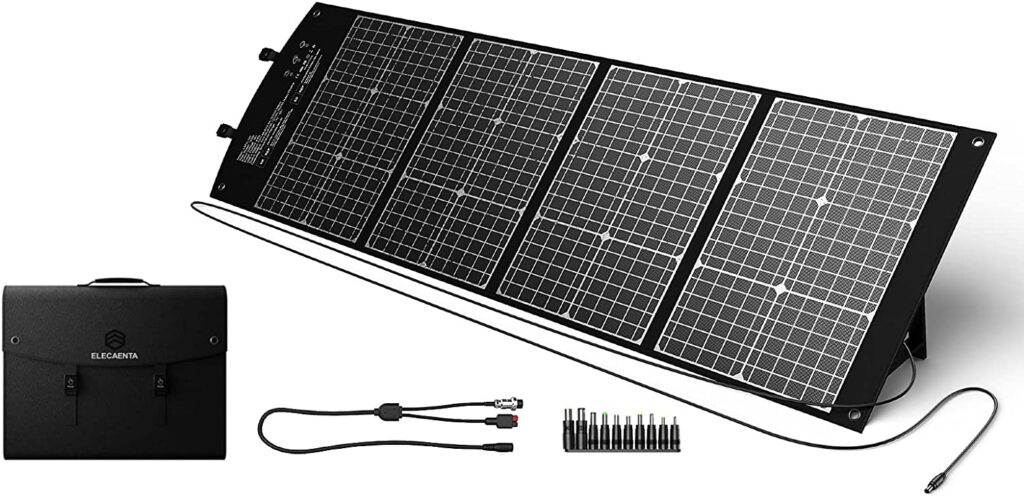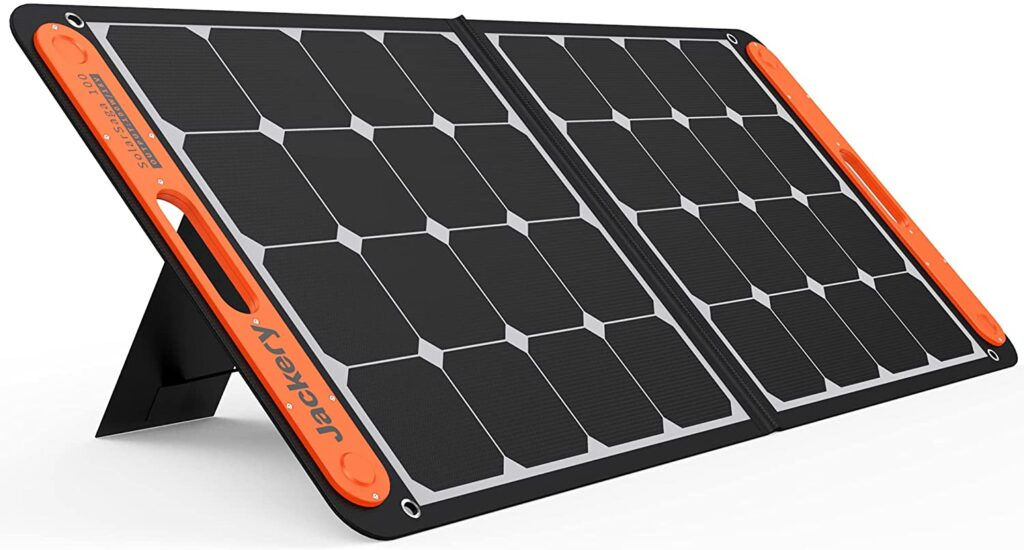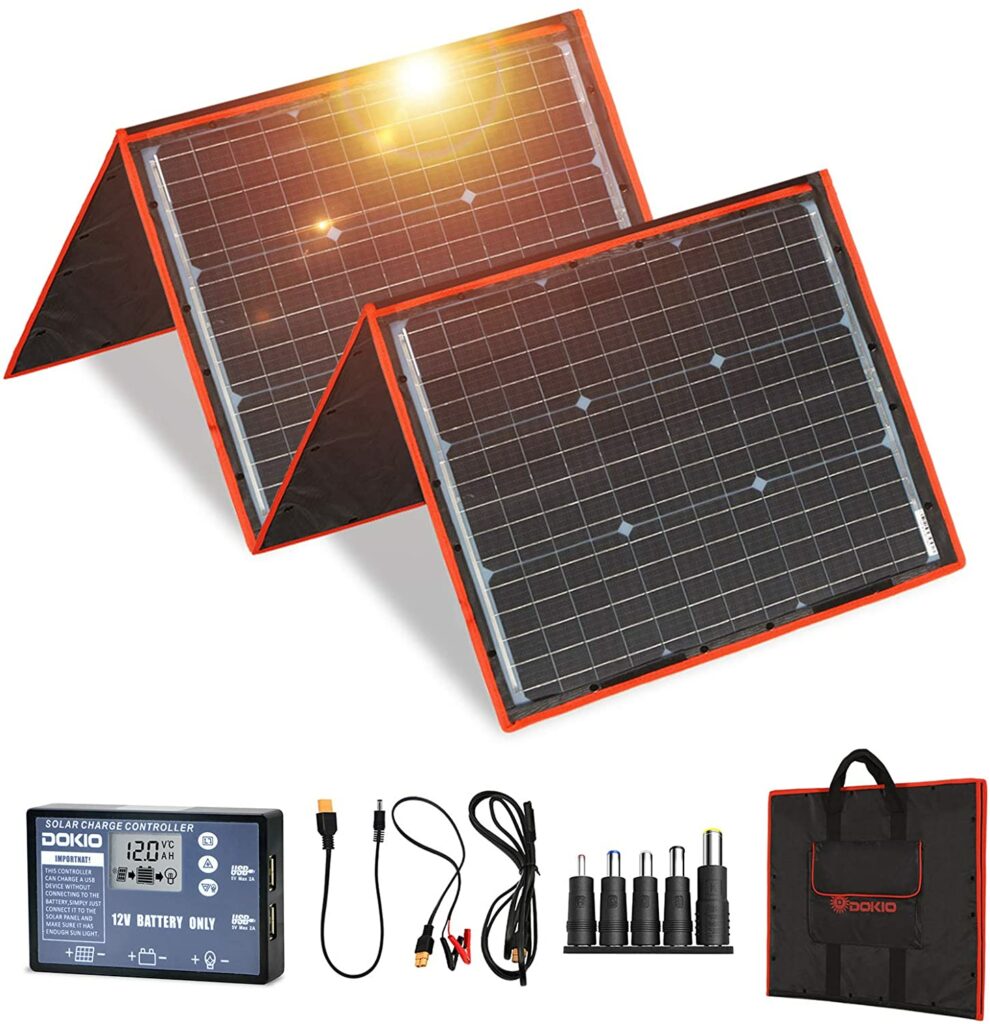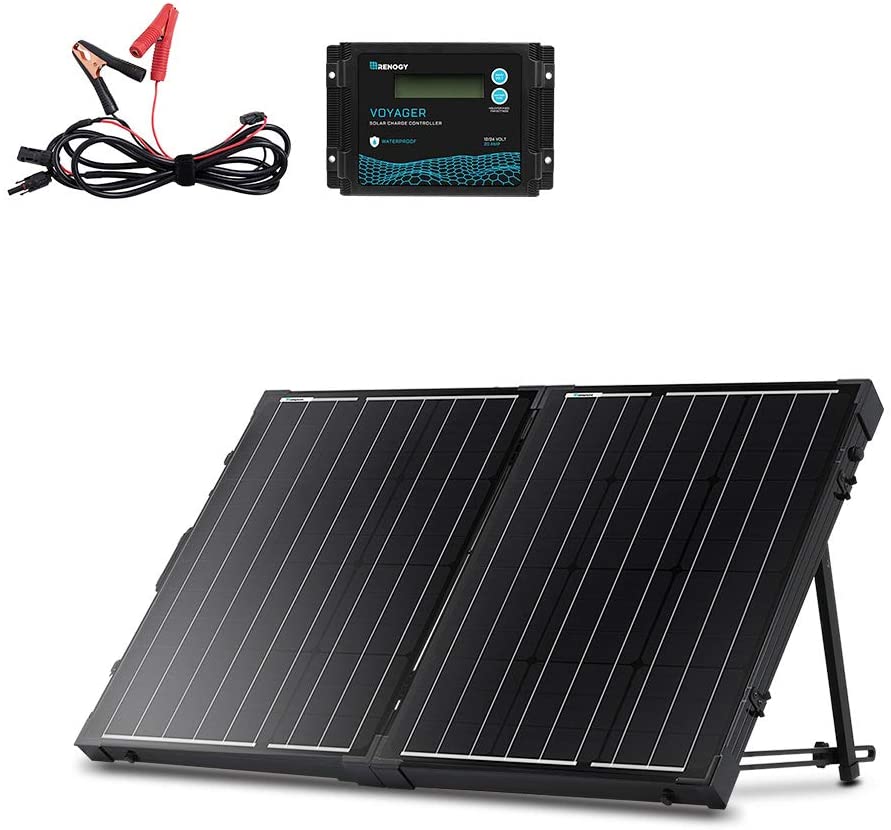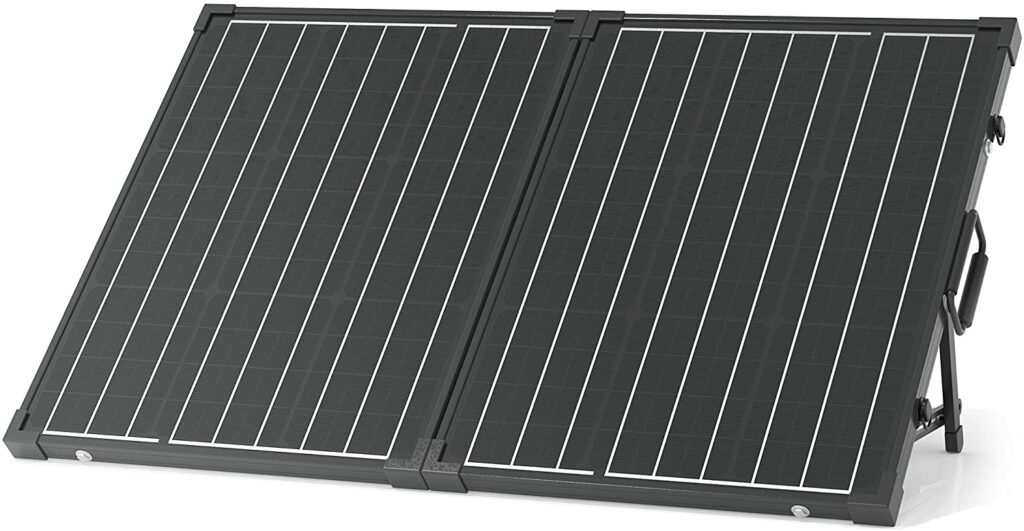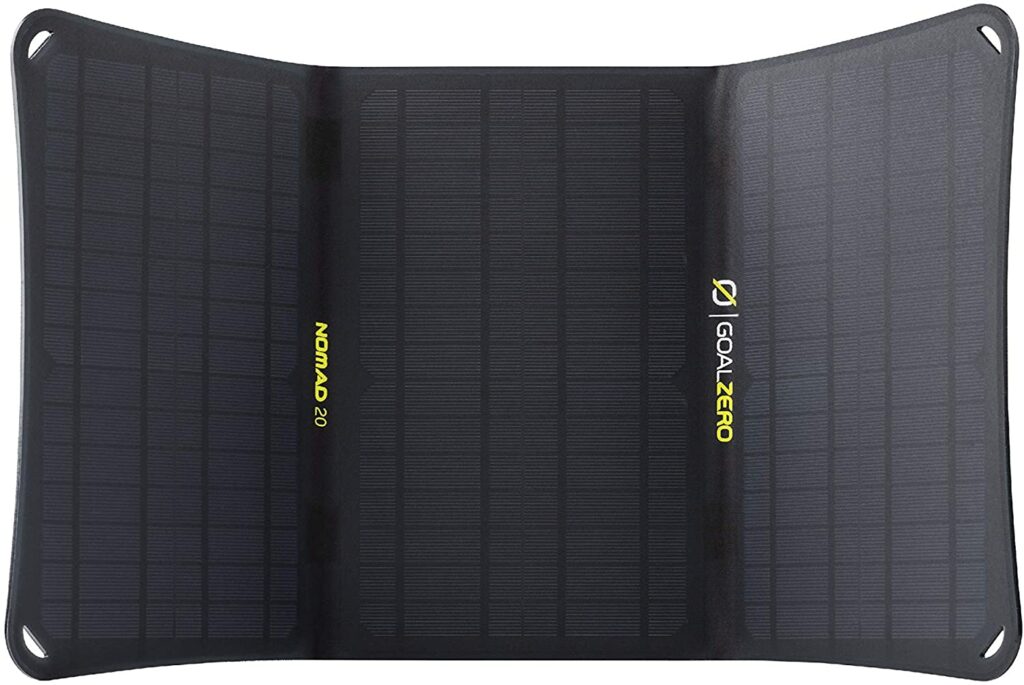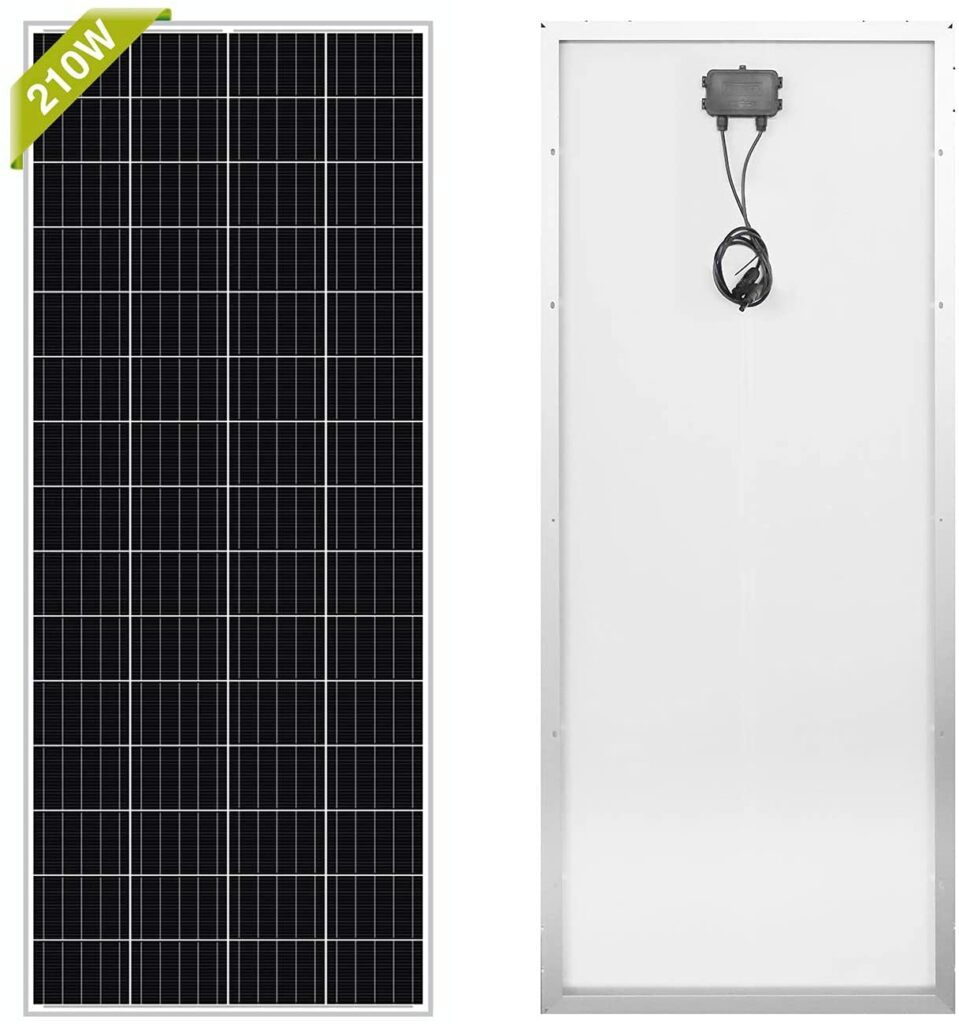
Planning an off-grid adventure but worried about staying powered? Portable solar panels are exactly what you need.
Today there are so many portable solar panel options available that one is sure to be perfect for you. Finding it may take some time and effort — both of which you’d rather spend outside doing something you love.
Whether it’s camping, hiking, RVing, or boating, we’ve got you covered. These top choices will also work during home power outages when you need a quick charge in a hurry. Preppers living off-grid will find these selections will meet their requirements, too.
At the end of this article, you’ll find a helpful buying guide on the best portable solar panel for you. To go straight to the list, click here.
How this list of the best portable solar panels was developed

We carefully analyzed the spec sheets of portable solar modules, consulted with experts, grilled customer service reps with questions, and read hundreds of customer reviews before making our final selections.
Of course, our personal experiences in the field with certain solar brands and solar panels influenced our choices, too, but we tried not to let personal biases get in the way of objectivity.
Granted, solar panel efficiency and power rating are important when it comes to choosing the best portable solar panels. You can’t forget the quality of the charge controller and connectors (if you go that route) as playing a critical role in the overall performance of your portable solar panel.
But there’s a lot more to take into consideration when deciding on the best portable solar panel for you.
Some of the characteristics that we scoped for and cross-compared among top candidates for our list include: ease of setup and operation, durability, reliability, and angle adjustability.
Here are the 7 best portable solar panels categorized for you to make it even easier to go solar whatever your outdoor passion may be.
The 7 best portable solar panels: At a glance
- Best all-around: Elecaenta Portable Solar Panel 120W 18V
- Best all-around runner up: Jackery SolarSaga 100W 18V Portable Solar Panel
- Best budget: Dokio 160 Watts 18 Volts Portable Solar Charger
- Best RV and camping: Renogy 200W 12V-20A
- Best RV and camping runner-up: Acopower UV11007GD 100W 12V Solar Panel
- Best one-day outing: Goal Zero Nomad 20 Foldable Solar Panel
- Best marine: Newpowa 210W Solar Panel
Best all-around portable solar panel: Elecaenta Portable Solar Panel 120W 18V
Hard to know where to begin raving about Elecaenta.
For starters, it’s highly efficient: 24%! For this price point, you can’t beat that. Anywhere.
One of the reasons for its high solar energy conversion is the ETFE coating. Unlike the conventional PET coating on most solar panels which dull or even become yellow over time, ETFE allows more light to enter the solar cells. ETFE also enhances module durability.
Instead of a charge controller, Elecaenta uses smart chip technology built directly into its USB ports, protecting your sensitive electronics from overcharging.
Besides all this great stuff, this product is extremely versatile. With 11+ connectors, you’re sure to find the one that your device — no matter how unusual — will fit into.
Metal eyelets (with four carabiner clips included) allow you to hang it up for better sun exposure. Otherwise, the kickstands permit you to angle the modules for ideal solar absorption.
Elecaenta is light enough and easy to operate. You can whip it out, charge up your devices, and then pack it up until the next power need arises.
What we like about Elecaenta Portable Solar Panel 120W 18V:
- Comes with 11+ different sizes of DC connectors
- DC-Anderson cable included
- Contains Type-C outputs
- Can charge devices using both DC and USB outputs at the same time
- Compatible with all major portable solar generators
What we don’t like about Elecaenta Portable Solar Panel 120W 18V:
- Doesn’t come with MC4 adapters
Elecaenta Portable Solar Panel 120W 18V specs:
- Wattage: 120 W
- Panel type: Monocrystalline
- Weight: 11.24 lbs.
- Dimensions: 20.47 x 14.17 x 2.17 in.
- Price: $206
Best all-around portable solar panel runner up: Jackery SolarSaga 100W/18V Portable Solar Panel
Jackery has established itself as one of the leading companies in portable solar options for off-grid adventures, with good reason. Even a quick glance at its SolarSaga 100W portable solar panel will soon astound you as it does us.
With an efficiency of up to 23%, the SolarSaga is at the top of what it can do for you with direct full sun on it. Adjustable kickstands will allow you to score the perfect angle any time of the day.
USB A and C ports with an LED indicator light allow you to directly and fully charge some of your electronic gizmos in no time at all.
Folds up easily. Comfortable handle lets you bring the lightweight SolarSaga along on the trail if you so desire.
Storage bag included.
This 100W solar module can charge up a solar power station in a few hours (under optimal conditions). If you don’t need a lot of power, Jackery’s 60W portable solar panel may suit you better.
What we like about Jackery SolarSaga 100W Portable Solar Panel:
- Two-year warranty (3 years if you register with the company)
- IP65 water resistant
- ETFE coating
What we don’t like about Jackery SolarSaga 100W Portable Solar Panel:
- Compatible only with some Jackery power stations
- Cannot support PD charging
Jackery SolarSaga 100W Portable Solar Panel specs:
- Wattage: 1o0 W
- Panel type: Monocrystalline
- Weight: 9.1 lbs.
- Dimensions (folded): 22.83 x 19.69 x 2.36 in.
- Price: $300
Best budget portable solar panel: Dokio 160 Watts 18 Volts Portable Solar Charger
Lightweight and foldable, the Dokio 160W 18V has a wattage rating that’s certainly high enough to work for any weekend camping excursions you have planned (assuming the weather looks sunny at least some of the time).
Even though Dokio 160W is light, you may be surprised by its high efficiency: up to 23% under optimal conditions.
This budget panel is compatible with most 12V battery types, including AGM and LiFePo4, as well as solar generators.
The Dokio 160W comes with its own Dokio charge controller.
Although the Dokio doesn’t have all the bells and whistles that other portable solar panels on this list have, for its price, you’d be hard pressed to find a better one out there.
What we like about Dokio 160 Watts 18 Volts Portable Solar Charger:
- Lightweight
- 5 DC conversion adaptors
- ETFE coating
What we don’t like about Dokio 160 Watts 18 Volts Portable Solar Charger:
- Charge controller is rated for only 10 amps
- No kickstand or metal eyelets
- No MC4 adaptor
Dokio 160 Watts 18 Volts Portable Solar Charger specs:
- Wattage: 160 W
- Panel type: Monocrystalline
- Weight: 9 lbs.
- Dimensions: 21 x 19 x 0.9 in.
- Price: $170
Best portable solar panel for RV and camping: Renogy 200 Watt 12 V Monocrystalline Foldable Solar Suitcase, 200W Panel-20A Controller
When you need plenty of juice for the many appliances and gadgets you have, choose the 200W Renogy solar suitcase.
Renogy is a trusted name in the solar world, covering your every need when relying on solar power off-grid. Renogy is your company if you want to build your own off-grid solar array for a home in the backcountry, or if you’re looking for a portable solar panel for an outdoor day trip.
The monocrystalline panels offered by Renogy are among the most efficient on the market today. This package consists of two 100W panels.
With this particular Renogy product, you benefit from having a solar charge controller already built-in. Negative grounding of Renogy’s own Voyager waterproof PWM controller makes it ideal for RVs and trailers.
The low voltage in this solar option compared to others means less risk of electric shocks — important if you have curious little ones who like to explore when you’re not looking.
Unlike some competitors, the Renogy 200W is compatible with lead-acid and lithium batteries including gel, AGM, and flooded batteries.
Storage case included.
What we like about Renogy 200W-20A Controller:
- Adjustable aluminum stand
- Built-in charge controller
- Compatible with different battery types
What we don’t like about Renogy 200W-20A Controller:
- Not compatible with Bluetooth
- No direct USB port
- Heavy unit
Renogy 200W-20A Controller specs:
- Wattage: 200 W
- Panel type: Monocrystalline
- Weight: 43.5 lbs.
- Dimensions (folded): 35.6 x 25.9 x 3.1 in
- Price: $340
Best RV and camping portable solar panel runner up: Acopower UV11007GD 100W 12V Solar Panel
Consisting of two 50W panels folded together, the Acopower UV11007GD can be quickly set up beside your vehicle and begin charging batteries and solar generators — even at the same time.
This runner up PV panel comes complete with its own built-in charge controller, MC4 connectors (2 pairs), Anderson connectors (1 pair), and battery terminal clips. It will charge sealed, gel, and flooded batteries.
With the MC4 connectors you could attach another 100W panel for more power output. (Don’t forget to upgrade the charge controller if you do. A 50W panel attached to this 100W panel will work with this controller.)
When the panels are connected in series, you could charge a 24V battery. Connect them in parallel to charge a 12V battery.
This Acopower PV panel comes with a carrying case.
If you want to charge lithium batteries, Acopower offers an upgrade.
The charge controller is removable, so you can upgrade that if you’d like to with a higher quality device that will improve efficiency by up to 30%.
What we like about Acopower UV11007GD 100W 12V Solar Panel:
- Corner protectors
- Adjustable legs
- Highly upgradable
What we don’t like about Acopower UV11007GD 100W 12V Solar Panel:
- Charge controller is rated for only 10 amps
- Charge controller is not waterproof
- Efficiency is only 15.4%
Acopower UV11007GD 100W 12V Solar Panel specs:
- Wattage: 100 W
- Panel type: Monocrystalline
- Weight: 33.1 lbs.
- Dimensions (folded): 19.69 x 25.6 x2.9 in.
- Price: $260
Best portable solar panel for one-day outings: Goal Zero Nomad 20W 18V Solar Panel
For all you nomads out there, you never want to go without a Goal Zero 20W backpackable solar panel.
You can grab-n-go the Nomad 20W on day hikes, beach days, or at festivals, prop it up, and start powering your devices before moving on to another place. Then repeat.
Just unfold it like a 3-paneled brochure and set it up at the optimal angle by its adjustable kickstand. This solar baby can also be used to charge a solar power bank.
A 6-ft. long 8mm cable allows for chaining other PV panels to the Nomad 20 for a faster charge and greater power output.
Minimalists may prefer the even tinier Nomad 10W.
What we like about Goal Zero Nomad 20 Plus Solar Panel:
- Super lightweight
- 1 yr. manufacturer warranty
What we don’t like about Goal Zero Nomad 20 Plus Solar Panel:
- Only has one USB port
Goal Zero Nomad 20 Plus Solar Panel specs:
- Wattage: 20 W
- Panel type: Monocrystalline
- Weight: 2.25 lbs.
- Dimensions: 11.5 x 7.4 x 1.25 in.
- Price: $150
Best portable solar panel for marine use: Newpowa 210W 12V Solar Panel
These Newpowa panels hold up exceptionally well in wind and hail storms plus they are water-resistant making them suitable for long boat trips in unknown waters with unpredictable weather.
Pre-drilled holes in its heavy duty frame make it easy to attach to your vessel. Built-in MC4 connectors with a 3ft. cable allow for joining PV panels in a large array with greater power output.
The waterproof junction box contains built-in bypass diodes that reduce power drops caused by shading or obstructions.
What we like about Newpowa 210W Solar Panel Monocrystalline 12V:
- Corrosion-resistant frame
- Ruggedness and waterproofness against extreme weather
- 25-year (80%) transferable power output warranty
What we don’t like about Newpowa 210W Solar Panel Monocrystalline 12V:
- Charge controller not included
- Mounting brackets not included
- Efficiency rating not stated on the Newpowa website (just “Class A high efficiency”)
Newpowa 210W 12V Solar Panel Monocrystalline 12V specs:
- Wattage: 210 W
- Panel type: Monocrystalline
- Weight: 24.4 lbs.
- Dimensions (folded): 64.57 x 26.57 x1.38 in.
- Price: $210
Best portable solar panels: Buying guide
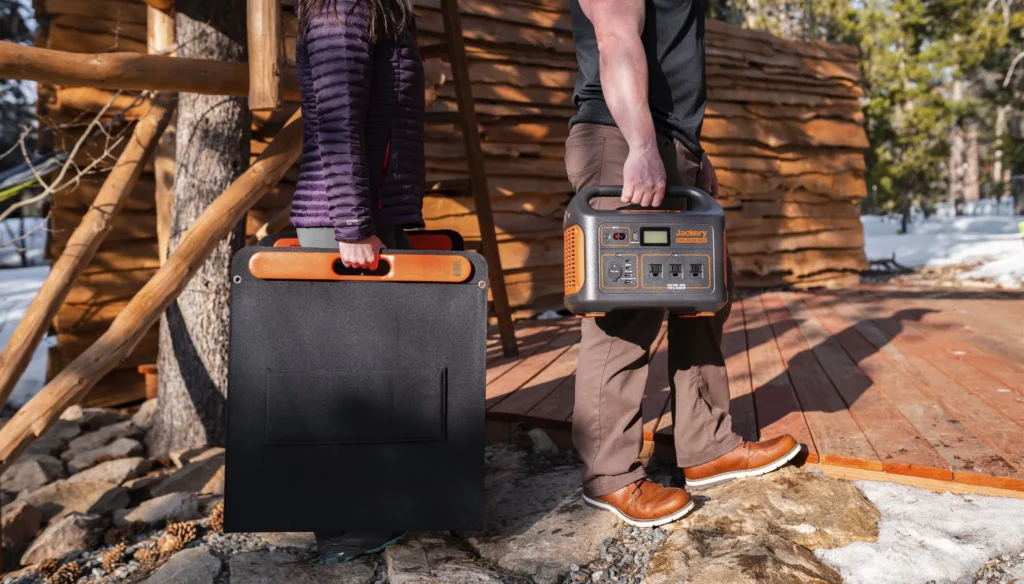
You don’t have to feel overwhelmed by the tons of specs and special features on portable solar panels. But you shouldn’t just blindly purchase the first thing you find, either. You could be throwing money away.
Here we briefly run down the essentials on how to shop for portable solar panels.
Portable solar panel usage
The best portable solar panel for you depends first and foremost on how you’re going to use it.
If you’ll be RVing or camping for an extended period, or living off-grid in a remote area, a module of at least 100W is essential.
So that you’ll never run out of juice, you’ll need a battery pack and a charge controller compatible with it. To give yourself some wiggle room, knowing that panel efficiencies in the real world rarely if ever hit their stated rating and are often much less than the stated rating, aim for a higher wattage from the start.
If you’re into boating, it is absolutely critical that the solar module and the junction box (if there is one) on the back are waterproof. Look for an IP65 rating.
For ocean use, look for information on salt resistance. Ask the company if you can’t find it.
Maybe you’re just planning a day trip and worry if you’ll be able to take all the videos and photos you’d like to. So a portable solar panel that can fit in a backpack and is light as a feather is what you’re after.
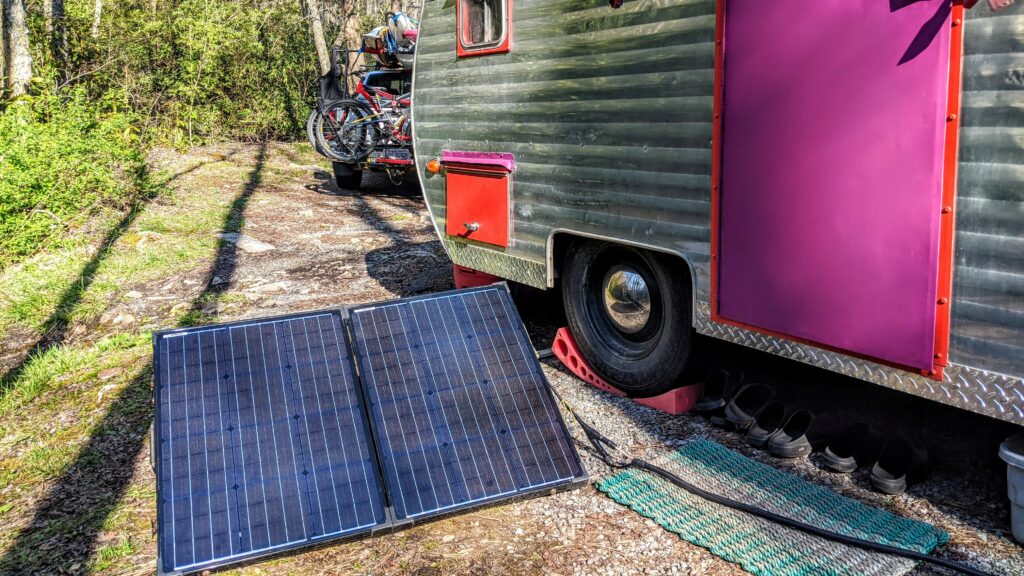
Calculating portable solar panel wattage
Individual portable solar panels on the market today range widely in wattage from as low as 10W up to 300W. The wattage rating describes the power output that the modules are capable of.
Usually, the higher the wattage, the more expensive the module is. So to avoid purchasing more than you need to meet your personal energy demand while adventuring away from the electric grid, it’s worthwhile to do a few simple calculations.
Note that you can always connect individual panels into an array to generate more power, too, when you’re away from home. For this overview of portable solar panels, we’re considering just one module at a time. If you used several together, the calculations described here would be the same, just multiplied by the total number of panels you’re using at once.
To find out the best wattage rating to meet your needs, you’ll need to calculate the total power consumption of all the devices and/or appliances for the time you’ll be operating them for however long you’ll want to function without a public utility power supply.
Since you’ll be estimating your total energy demand, it’s a good idea to round up (not down) to be sure you won’t fall short. For example, if you calculate that you need 175W, purchase a 200W panel instead.
Of course, there are many variables that influence how much wattage actually gets delivered to your devices and appliances. The major factors that affect final power output include:
- Solar panel efficiency
- Weather
- Location
- Season
- Shading and obstructions
- Charge controller (if used)
- Inverter (if used)
Nevertheless, you still must figure out a good estimate of the power consumption (measured in watts) of all your devices and appliances. Then you use that value to determine how much energy output you need from your portable solar panels for the length of time you’ll be using them (usually in a single day).
Since the energy output relates power consumed by your stuff and the time you use it, you calculate energy output by multiplying power by time to get a number measured in watt-hours (Wh).
As an example, add up the power consumed by all your appliances and devices by looking at their labels. Smartphones, tablets, etc. are included.
Assume it’s 120 watts. If you’ll be using them for four hours a day, this equals a total of 120W x 4hrs. = 480 Wh, which is the energy output you need.
To find out the minimum size solar module (in terms of wattage — not physical dimensions of length, width, and height) you need to produce 480 Wh in one day, divide 480 Wh by the number of sun hours your panels receive in a single day.
How much sun exposure your panels actually get depends on your location, season, and the angle at which your panels are oriented toward the sun. For this example, assume it’s five hours.
However, you need to account for less than ideal conditions and any energy losses from a charge controller and/or inverter (if you’re using them). So, assume only 75% of the stated wattage rating is actually delivered to your devices and appliances.
480 Wh / (5 hrs. x 0.75) = 128W
This means the minimum panel wattage you should buy should be slightly higher, like 130W, to be sure you cover all your bases. (We’d personally go with 150W, but that’s just our preference based on experience.)
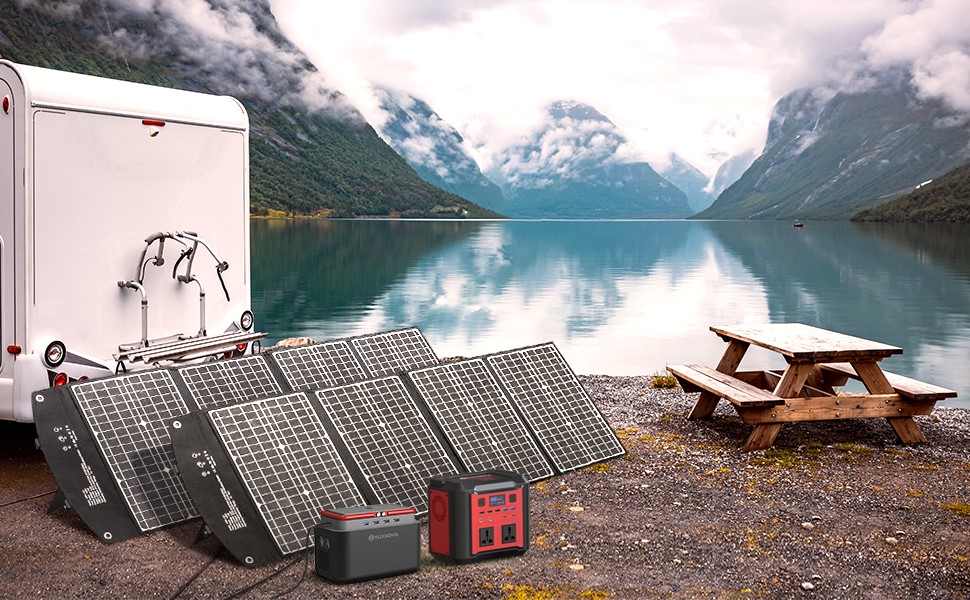
Portable solar panel efficiency
The best portable solar panels on the market today have an efficiency of approximately 24%.
This means of all the solar radiation they receive, the panels capture less than a quarter of it. Under perfect conditions, this small percentage is transformed into usable direct current (DC) electricity.
Generally speaking, monocrystalline panels have greater efficiencies than polycrystalline panels. Both are significantly more efficient than thin-film solar panels.
When choosing the best portable solar panel, the highest efficiency panels will output more energy, all else being equal.
If you’re using a charge controller (for battery storage) and/or an inverter (for AC appliances), your power output will drop even further as energy is cycled from your PV cells through the controller and/or inverter before the energy reaches your gadgets and/or appliances.
In these cases, higher quality charge controllers and inverters will alleviate more of the output loss than those of inferior quality.
In this list of the top portable solar panels, a few use PWM controllers which are 30% less efficient than MPPT controllers. You may wish to upgrade to MPPT if your power production is significantly lower than what you’d expect it to be.
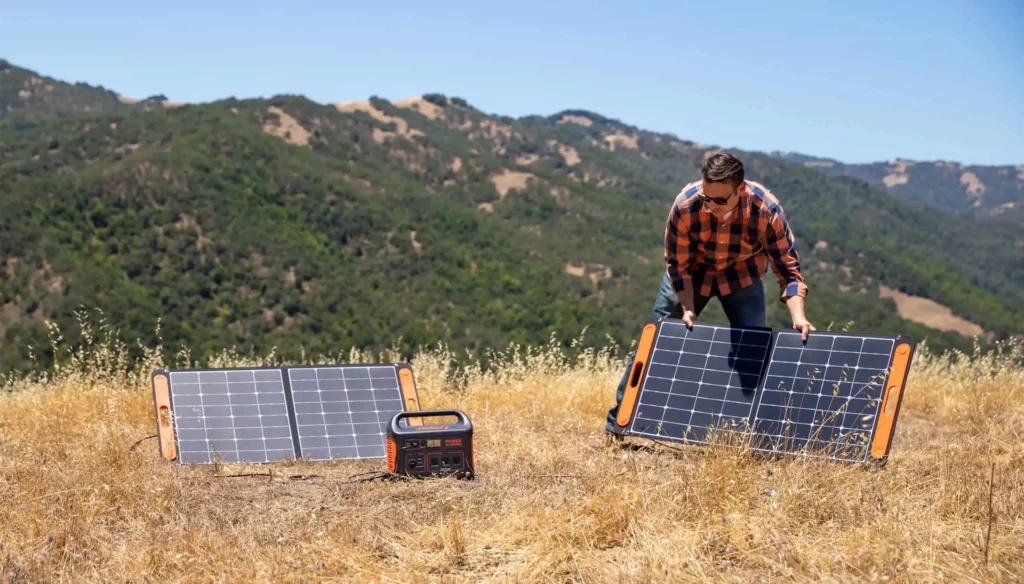
Choosing the best portable solar panels
With a multitude of portable solar panels options on the market today, you no longer need to travel with a gasoline-powered generator to keep your appliances and devices running.
Finding exactly what you need in a portable solar panel can be challenging. This list of the 7 best portable solar panels greatly simplifies the selection process for you.
There are certain portable solar panels that serve you better than others depending on your outdoor activity. Whether it’s camping, RVing, boating, or day hiking, you’ll find the most suitable portable solar panel on this list.
Any one of these 7 best portable solar panels will come in handy during home emergency outages when you’re in desperate need for power.
Survivalists living off-grid will find top-rated portable solar panels here, too, to meet their desire for energy independence.
With the portable solar panel buying guide in this article, you’ll have a better idea of what you’re looking for and feel good about your final choice. Then, you’ll be able to look forward to plenty of usable solar energy wherever your travels take you.
